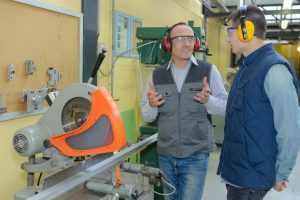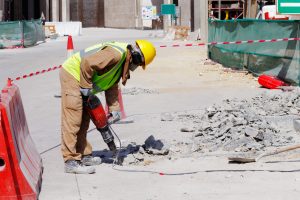If you need noise survey assistance as discussed in this article call us at 973-366-4660 or email us at info@atlenv.com for details and a free estimate.
Written by Robert E. Sheriff, MS, CIH, CSP, President
October 23, 2018; Updated November 2021
Noise Dosimetry Surveys
Whether they are subjected to a constant din or sporadic bursts of loud sounds throughout the day, employees in noisy workplaces are at risk of permanent damage to their hearing. For a noisy workplace, establishing a Hearing Conservation Program is imperative to protecting both employee health and employer liability.

Hearing Protection
Sometimes, determining the appropriate type of protection for each employee can be tricky because individual employees may have varying levels of exposure to different noise levels throughout the day. The best way to determine the volume, frequency, and length of noise exposure to each employee—or employee function—is through a noise dosimetry survey or noise testing/sampling.
Noise Dosimeter
A noise dosimeter is a small, unobtrusive meter that attaches to a worker’s belt and has a connection to a tiny microphone that clips on their collar, next to their ear. The device is worn throughout an entire 8-hour shift, measuring sound at ear level, and determining the average exposure level per shift for that individual.
New technology has minimized the noise dosimeter, and some are now so small they can be worn on the collar.
Noise dosimeters are not recorders but instead are sound level meters. They take noise readings at ½ or 1-second intervals and accumulate the measurements over the time-worn by the worker. The final read-out from the dosimeter is then compared to the OSHA Hearing Conservation limit (85 dB-A for an 8-hour work shift and 90 dB-A compliance level for an 8-hour day), or another recommended safe noise-exposure limit.

Each facility (factory, refinery, warehouse, etc.) has unique characteristics, employees and processes. Each facility also has federal, state and local regulations to consider. An experienced industrial hygienist is able to choose the appropriate noise dosimeter to be used, calibrate it before and after use, and provide results in a clearly written and comprehensive report with appropriate recommendations for noise reduction and regulatory compliance.

Based on the results, a Hearing Conservation Program can be developed or modified. Noise dosimetry surveys provide employers with the information needed to require workers to wear the most effective and least disruptive hearing personal protective equipment designed for each specific function.
An important complement to noise dosimetry is to develop a noise map of the work area. This will identify noisy areas that can be the target of noise reduction efforts should OSHA compliance be an issue or if noise reduction is desired. The noise map is developed with a handheld sound level meter (SLM). A qualified person such as an Industrial Hygienist can measure the noise throughout the facility. If there is a need for noise reduction, an Octave Hand Analyzer can identify specific frequencies that are excessive so that some engineering efforts can be implemented to achieve noise reduction.

To discuss your particular needs and obtain a complimentary proposal, contact us at 973-366-4660 or email at info@atlenv.com.
Our primary service areas for Noise Dosimetry and Noise Surveys are: New Jersey NJ, New York NY, (New York City), Pennsylvania PA, Connecticut CT, Delaware DE, Massachusetts, (Boston) MA, Rhode Island RI, Washington DC, Wisconsin WI, Maryland MD, Michigan MI, Illinois (Chicago) IL, Virginia VA, Indiana IN, Georgia (Atlanta) GA, Alabama AL, North Carolina NC, South Carolina SC, Tennessee TN, Texas (Dallas, Ft Worth) TX, Oklahoma OK, DC, Arkansas AR, Florida FL. We can service most other areas of the U.S. but additional travel charges will be applied.



